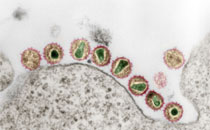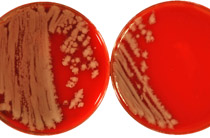Wunderlich K, Juozapaitis M, Maenz B, Mayer D, Goetz V, Zoehner A, Wolff T, Schwemmle M, Martin A (2010): Limited compatibility of polymerase subunit interactions in influenza A and B viruses
J. Biol. Chem. 285 (22): 16704-16712. Epub Apr 2.
Despite their close phylogenetic relationship, natural intertypic reassortants between influenza A (FluA) and B (FluB) viruses have not been described. Inefficient polymerase assembly of the three polymerase subunits may contribute to this incompatibility, especially since the known protein-protein interaction domains, including the PA-binding domain of PB1, are highly conserved for each virus type. Here we show that substitution of the FluA PA-binding domain (PB1-A1-25) with that of FluB (PB1-B1-25) is accompanied by reduced polymerase activity and viral growth of FluA. Consistent with these findings, surface plasmon resonance spectroscopy (SPR) measurements revealed that PA of FluA exhibits impaired affinity to biotinylated PB1-B1-25 peptides. PA of FluB showed no detectable affinity to biotinylated PB1-A1-25 peptides. Consequently, FluB PB1 harboring the PA-binding domain of FluA (PB1-AB) failed to assemble with PA and PB2 into an active polymerase complex. To regain functionality, we used a single amino acid substitution (T6Y) known to confer binding to PA of both virus types, which restored polymerase complex formation but surprisingly not polymerase activity for FluB. Taken together our results demonstrate that the conserved virus type-specific PA-binding domains differ in their affinity to PA, and thus might contribute to intertypic exclusion of reassortants between FluA and FluB viruses.






